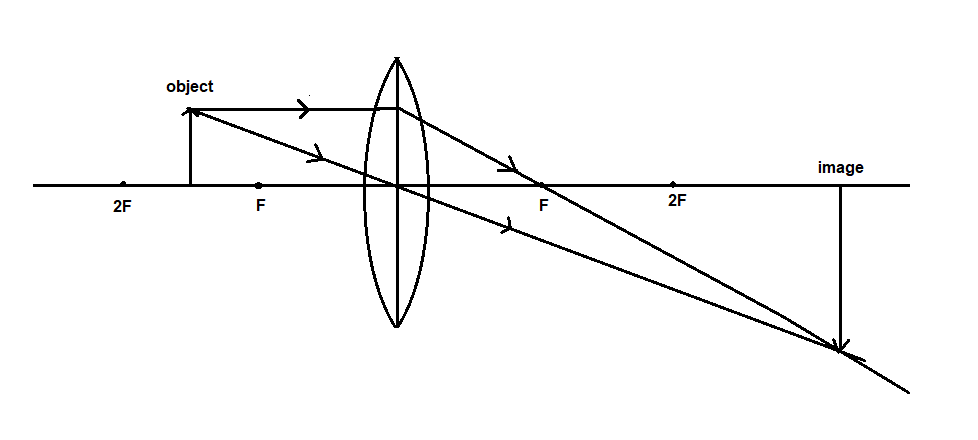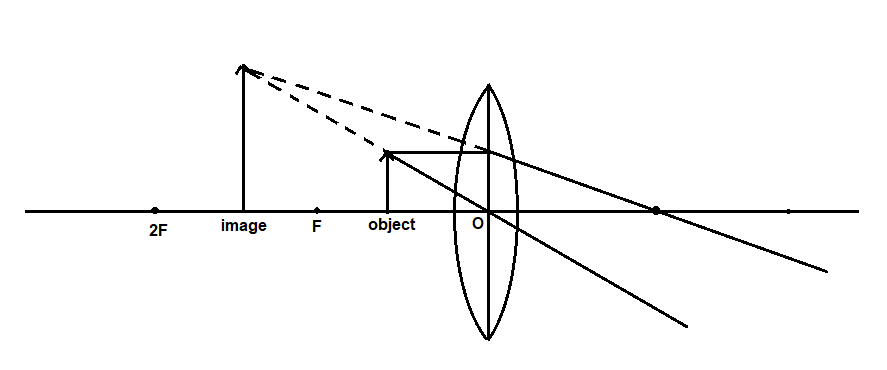
How can a converging lens produce a magnified image?
(A) When the object is beyond $2F$
(B) When the object is at $C$
(C) When the object is at $F$
(D) When the object is behind the mirror
Answer
215.1k+ views
Hint In a converging lens, all the rays that are parallel to the principal axis will converge to a fixed point on the principal axis. Such a lens is called a convex lens. Here, we have to find where we have to place the object to get a magnified image. We have to use a ray diagram to find the right answer.
Complete Step by step solution
In this case, the magnification of the image will happen when the object is placed between \[F\]and $2F$

The image will be formed on the opposite side of the lens and it will be located beyond $2F$ on the other side. The image will be inverted. The size of the image will be greater than that of the size of the object. This means that the image is magnified. Magnification is the ratio of the image size to the object size. For inverted images magnification will be negative and for real images, magnification will be positive.
Here the correct options are not listed among the given options.
Additional Information
The location of the image is where the light rays are converging. If we place a screen at that point we will get the projection of the image on the screen. When the object is placed on the focus $F$and on the center of curvature $C$the image will be of the same size as that object. So there will not be any magnification.
Note
Alternate answer:
The image will be magnified when the object is placed between the focus $F$and the optic centre $O$of the lens. The image will be formed on the same side as the object. The image will be erect and virtual. Therefore a converging lens is also used as a magnifying glass.

Complete Step by step solution
In this case, the magnification of the image will happen when the object is placed between \[F\]and $2F$

The image will be formed on the opposite side of the lens and it will be located beyond $2F$ on the other side. The image will be inverted. The size of the image will be greater than that of the size of the object. This means that the image is magnified. Magnification is the ratio of the image size to the object size. For inverted images magnification will be negative and for real images, magnification will be positive.
Here the correct options are not listed among the given options.
Additional Information
The location of the image is where the light rays are converging. If we place a screen at that point we will get the projection of the image on the screen. When the object is placed on the focus $F$and on the center of curvature $C$the image will be of the same size as that object. So there will not be any magnification.
Note
Alternate answer:
The image will be magnified when the object is placed between the focus $F$and the optic centre $O$of the lens. The image will be formed on the same side as the object. The image will be erect and virtual. Therefore a converging lens is also used as a magnifying glass.

Recently Updated Pages
Uniform Acceleration Explained: Formula, Examples & Graphs

Wheatstone Bridge Explained: Working, Formula & Uses

Young’s Double Slit Experiment Derivation Explained

Chemical Equation - Important Concepts and Tips for JEE

JEE Main 2022 (July 29th Shift 1) Chemistry Question Paper with Answer Key

Conduction, Transfer of Energy Important Concepts and Tips for JEE

Trending doubts
JEE Main 2026: Application Form Open, Exam Dates, Syllabus, Eligibility & Question Papers

JEE Main Correction Window 2026 Session 1 Dates Announced - Edit Form Details, Dates and Link

Equation of Trajectory in Projectile Motion: Derivation & Proof

JEE Main 2026 Application Login: Direct Link, Registration, Form Fill, and Steps

Hybridisation in Chemistry – Concept, Types & Applications

Angle of Deviation in a Prism – Formula, Diagram & Applications

Other Pages
JEE Advanced Marks vs Ranks 2025: Understanding Category-wise Qualifying Marks and Previous Year Cut-offs

Collision: Meaning, Types & Examples in Physics

How to Convert a Galvanometer into an Ammeter or Voltmeter

Atomic Structure: Definition, Models, and Examples

Degree of Dissociation: Meaning, Formula, Calculation & Uses

Average and RMS Value in Physics: Formula, Comparison & Application




